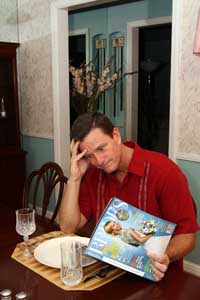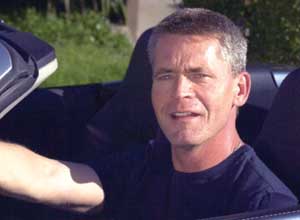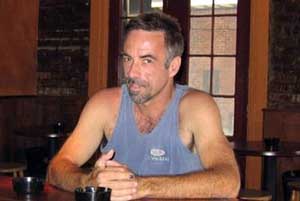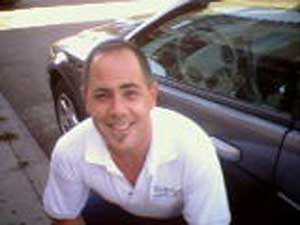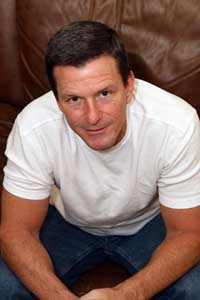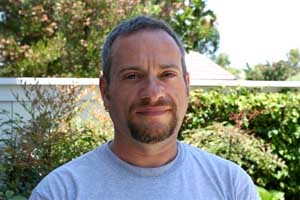-
- Fight against ‘judicial activism’ to continue despite election
- Catholic bishops pass guidelines to gay ministry
- Gay rights leader says election produced solid gains for gay community
- Mass. lawmakers delay decision to put same-sex marriage amendment on ballot
- HIV patients live years after diagnosis
- Houston landscaper accused of refusing service to gay couple
- National News Briefs
- World News Briefs
feature
Bachelors for life
What gay men in their 40s and 50s say about living single
Published Thursday, 16-Nov-2006 in issue 986
Most experts will tell you that middle-aged gay men and lesbians represent the first openly gay generation. Members of our community in their late 40s and early 50s have fought the hard fight for survival, recognition and respect. They represent the generation that battled alongside their heterosexual counterparts in the feminist movement. They represent the generation that was hit hardest by the then-largely misunderstood AIDS epidemic of the 1980s and ’90s. And they are, by and large, the first generation to have pursued adoption of children.
By the same token, they are also dealing with other issues, many of which are age-related and similar to their counterparts in the heterosexual community: physical health issues, menopause, relationships, the balance of work and play. But there are certain challenges that are unique to the gay and lesbian community as they move into their midlife. Especially if you happen to fit into a very significant portion of the community: middle-aged and single.
Culture of youth
Certainly the most commonly expressed challenge of aging is the reality that your body changes along the way.
Or, rather, says Doug Stein of Mission Hills, it’s not so much that your body is changing along the way but that the images that bombard us on a daily basis remain deeply rooted in youth.
“At 47, I feel like I am in the ancient category according to the gay community,” Stein says. “I think a lot of gay men tend to hang onto their youth a lot more, or even search for their own youth in younger men, as opposed to accepting the fact that they are aging.”
For Stein, age as a number is just one part of the issue.
“I think a lot of gay men are hung up on looks,” Stein explains. “And I don’t mean just looks in general. I mean looks in terms of age and youth. It seems like middle-aged gay men are looking for beautiful young models, stunning boys to have on their arm, rather than finding someone they are compatible with on different levels.”
Stein, who is recently out of a long-term relationship, says that at 47 there is a fear of whether one can find a quality relationship amidst the culture of youth that pervades the gay community.
“It is frightening to think about sometimes,” Stein says.
“At 47, I feel like I am in the ancient category according to the gay community. I think a lot of gay men tend to hang onto their youth a lot more, or even search for their own youth in younger men, as opposed to accepting the fact that they are aging.”
Regina Smalley, Ph.D., is a clinical psychologist who works with the gay and lesbian community. Smalley understands Stein’s concerns and sees these same concerns frequently in her practice, especially for those who are single.
“For some men, reaching middle age is different than other struggles they have faced,” Smalley says. “For men, there is typically more emphasis on youth and youthful experiences. Once you begin to put on some weight, perhaps the thinning hair, that experience can be painful. They may begin to experience some rejections they might not have had when they were younger.”
Charles Siegel, 48, of North Park, says he continues to surround himself with youthful people and activities.
“People often say to me, ‘How can you possibly not be married?’ which is an unbelievably nice question,” Siegel says. “I have always tended to be single, but most of my friends tend to be younger, and I look younger than I am. I guess I tend to be more active in stuff that people think of as younger. It’s just natural for me; nothing wrong with either way.”
Seigel’s activities consist of going to the gym every day, bicycling, circuit parties, restaurants – “the normal stuff,” Seigel says.
For Frank Angel, 47, finding a space where youth and beauty are relative has been important to him. Angel splits his time between his primary home in Palm Springs, and San Diego and San Francisco.
“I live in Palm Springs most of the time,” Angel explains. “Age isn’t so much a problem [in Palm Springs] because by comparison I am still young. But when I was in my 30s, I lived in West Hollywood, and I felt completely invisible. I had to get out of there. I think people should find a space where they feel their best, even if that means up and moving. …”
This feeling of being “invisible” comes up frequently in discussions of aging in the gay community.
Michael Chapnick, 45, of Normal Heights, says he understands that feeling.
“I think from a single person’s perspective, there is this gay culture fascination with youth,” Chapnick says. “As you age, you fall out of grace in some ways. Perhaps you are overlooked a little. When I was younger, I would go to clubs and I was the cute one, the one people would buy drinks for. I find that that’s changed. In some ways I guess I feel a little more invisible.”
And that applies equally to men his own age, Chapnick says.
“It’s even harder to find somebody, a man my own age, who is interested in dating in the same age category,” Chapnick explains. “Even men who are middle-aged seem to be looking for the younger guy.”
For Michael Lamb, 46, of North Park, it’s about putting yourself in the right place.
“There is a standard of beauty and more pressure to maintain fitness, skin, to look good,” Lamb explains. “And, sure, when I was younger, people were always asking to buy me drinks. I guess a pretty face means a lot. What I do, though, is I choose where I hang out. So I just hang out where people will appreciate me.”
Scott Nimmo, 51, lives in Chula Vista. Like many gay men, he lives outside of the gay urban center of San Diego, but says he still feels a part of the community emotionally.
Nimmo came out later in life. His views are often colored by his age in terms of what he witnessed of the gay community and its rise during the last 30 years or so.
“I didn’t come out until I was 32,” Nimmo explains. “I wanted desperately to feel a part of this group, this gay group, 20 years ago. But now I see how the community has prioritized its values, and I wonder where we lost the opportunity to be creative, innovative. When I was coming out, there was this sense of freedom that we didn’t have to be married and have children, there were no constraints, there was none of this judgmental, critical or negative oppression within the community. It was all external.
“There is such a pressure to conform,” Nimmo says. “It’s the Pamela Anderson approach: If you don’t have your tits stacked high up, your hair blown out and a killer ass to knock ’em dead on the walk-away, you can forget it. I would love to see the old ’70s unconventional life return, where anything is possible and there are new approaches to things for people my age.”
Seth Perkins, 49, of Mission Hills, puts it this way.
“You know that song, ‘Mr. Cellophane’ in the musical Chicago?” Perkins asks. “That’s middle-aged gay America. So you’ve got to go where they’ll give you an Oscar nom for being the invisible man!”
“If you aren’t coupled by 40 or 45, I think chances are you already have a strong enough adopted family – friends and so on – that a primary relationship doesn’t seem as necessary.”
And then there is the whole issue of those who maintain the set standards. Perkins says so many of his friends are maintaining built physiques through working out and/or cosmetic surgery that it has become somewhat of a joke in his circle of friends.
“There’s this sense of wanting to make sure that you look buff and fit and masculine,” Perkins explains. “But then when you see some middle-aged guy walking down the street looking completely ripped, you think, ‘Well, he must be pretty insecure and trivial.’ Sort of like straight men and the red Corvettes back home.”
What’s more, says Perkins, is that most of his friends who maintain their physiques to prescribed “beauty and youth” standards are really quite uninterested in doing so.
“I have one friend who always says, ‘I may look like a bald eagle but I flit like a butterfly,’” Perkins jokes.
What Perkins is describing is the duplicity paradox of maintaining a physical standard on the outside that is out of sync with the mental, emotional or spiritual core inside. Perkins references a study called “Ageing Gay Men: Lessons from the Sociology of Embodiment,” by Julie Jones and Steve Pugh.
According to the study, “A concern over carrying an appearance off does not necessarily imply a deep and abiding identification with that appearance.”
In fact, Jones and Pugh argue: “The duality, which is expressed in [the duplicity paradox], has application to gay men in their presentation of themselves as objects of desire. Gay men who are toned and who epitomize ideals of the male body – developed pectorals, six-pack abdomen and bulging biceps – and who present themselves in fashionable attire may be equally regarded as insincere and trivial. This emphasis on the body – this narcissism – undermines their value as individuals, which is reinforced by the sometimes-casual nature of gay sex with its emphasis on immediate satisfaction.”
Perkins, who admits to visiting the gym three to four times a week, will be the first to say that there are other ways he would rather spend his time.
“If I had my way, I would be out reading a book, sipping tea and sitting under an umbrella,” Perkins says. “But I’d be afraid people would walk by and holler ‘sissy’ comments at me. Instead, I spend my time sweating away [at the gym] in hopes that on the off-chance some guy walks by me on the street, he’ll think I’m butch and want to ask me out. The only problem is that when he asks me what I want to do on a date, I have to confess that my preference is to see Guys and Dolls for the 4,356th time!
“I can be just as intimidated on the street by other gay men as I can by straight men. It’s like being right back in junior high and not wanting to be the one who looked like a target getting shoved against the locker.”
Accelerated aging
Another commonly cited phenomenon when dealing with middle-aged gay men is what Anglyn Sasser, Ph.D., calls “accelerated aging.”
“What I have seen, and this is obviously more evident among gay men than women, is there seems to be this element of surprise to men that they have reached middle age,” Sasser says. “Middle-aged men tend to participate in what is called accelerated aging, where they perceive others to be older than they themselves actually are, often not applying it to themselves those youth and beauty standards.”
According to a study done in Australia under the direction of sexuality experts Keith C. Bennett and Norman L. Thompson (“Accelerated Aging and Male Homosexuality: Australian Evidence in a Continuing Debate”): “Because of the gay community’s emphasis on youth, homosexual men are considered middle-aged … by other homosexual men at an earlier age than heterosexual men in the general community. Since these age-status norms occur earlier in the gay sub-culture, the homosexual man thinks of himself as middle-aged and old before his heterosexual counterpart does.”
There is an added challenge for men, specifically. Men have no biological marker, per se. Most women, on the other hand, have menopause as a process which they know they will inherently go through and likely have been discussing with friends, family and even physicians for some years. And so, says Smalley, there is an added biological marker that may factor into the fact that middle age may come as less of a surprise to women as to men.
For Rick Vella, 46, of North Park, realizing he was classified as middle-aged came as a shock.
“I was depressed for like a week,” Vella explains. “We think that the life span has increased, then suddenly you are 40, everyone is telling you that 40 is the new 30, but then people say, no, you’re really middle-aged.”
For Vella, whose life is spent in the public eye, after spending some time accepting his age, being middle-aged has just become another label.
“We have so many labels and we don’t even realize it,” Vella says.
Middle-aged and single: choice?
“I spend my time sweating away [at the gym] in hopes that on the off-chance some guy walks by me on the street, he’ll think I’m butch and want to ask me out. The only problem is that when he asks me what I want to do on a date, I have to confess that my preference is to see Guys and Dolls for the 4,356th time!”
The fact is that most middle-aged gay men are single, often unlike their straight counterparts. So the question is why?
For Gary Martinez, 46, the answer is simple: “I’m selective.”
It may sound like a cop-out to some, Martinez says, but it is a very real and living truth for many middle-aged gay men. After all, as one ages, one’s preferences do become more refined in many areas: one has a certain taste in food or drink, a certain standard of travel or living, perhaps even a standard of job one would accept.
“So why not the same standards in a relationship?” Martinez asks. “Honestly, most of my friends who are together met early on. You know them. They’re the couple that has been together 83 years, met in college or shortly after they moved to San Diego. If you aren’t coupled by 40 or 45, I think chances are you already have a strong enough adopted family – friends and so on – that a primary relationship doesn’t seem as necessary.”
For Sasser, this idea of a strong family of choice is critical.
“The stronger the family of choice, the friends, the people one surrounds oneself with,” Sasser explains, “the better one is able to deal with the changes in their life. The stronger the support network, the less concern and anxiety, the less isolation.”
On the flipside are the concerns if one is without a strong support network.
“When people reach middle age, and especially if they are single, they are likely to have increased anxiety because they are looking outside the social support network, seeing if they will have the financial ability to take care of themselves” Sasser says. “In many ways, even gay couples have this anxiety because they simply don’t have the same rights and privileges of a heterosexual married couple. But for the single person the questions really come in: ‘Who will take care of me? Have I planned right? Have I saved enough?’”
Positively middle-aged
For some middle-aged gay men there is an added challenge: HIV. As the generation who first encountered HIV and AIDS, many gay men have experienced significant loss in terms of friends and loved ones. For those who have survived, there are other losses to deal with.
For Angel, being HIV positive presents its own challenges in terms of physical appearance.
“I guess staying at the top of my game, looking good means looking like I don’t have AIDS,” Angel says. “Being beautiful in that way, I guess, means more about beauty from the perspective of looking healthy, not so much looking young. In that way, I focus more on working out and skin care – the hair left a long time ago.”
For Rodney Isherwood, 46, of Hillcrest, being HIV positive plays a significant role in his self-image.
“I became positive when I was 27, so that is, what, almost 20 years ago?” Isherwood explains. “I’ve been through more medication than you can imagine, and in many cases those have had pretty rough side effects. So, in some ways, age isn’t the factor but being HIV positive is.”
Nimmo describes his HIV as it relates to the rest of his life: “I always say that in terms of the gay community, I’m too old, too hairy and I’ve got HIV. How do you compete in a community like that?”
Smalley says she sees this frequently.
“There is a sense [that] those who have been on medications for longer periods of time will have the classical physical side effects we associate with HIV medications,” Smalley explains. “And now you are seeing all of these ads for cosmetic surgery, Botox, all of these procedures to compensate for the physical impact of those medications.”
Which, argues Smalley, often brings one back to the issue that health and beauty and youth and physical appearance are critical to members of the gay community.
However, like coming out, sero-converting also adds to a person’s ability to handle crisis.
Chapnick, who sero-converted in his early 30s, says in some ways becoming HIV positive prepared him for his struggle with middle age.
“When you become positive, you reassess things,” Chapnick says. And so Chapnick, who came out early and was diagnosed with HIV in his 30s, has already dealt with two social stigmas. “What’s realizing you’re 40 and middle age compared with those?”
Many middle-aged gay men have long lost their partners to HIV and AIDS, Smalley says.
Timothy Dolvier, 46, of Kensington, lost his partner to AIDS three years ago. Dunlap, who is also HIV positive, says it was a very difficult process; something he would never wish on someone else.
“I watched this incredibly vibrant man, a guy I used to kayak with and run with and play football in college with, waste away to nothing,” Dolvier recalls. “I guess the truth is that I still kayak, I still run and I could play football if I wanted to, and I just don’t want to put someone through the same loss I went through.”
Dolvier is very guarded in his approach to making new friends. In fact, Dolvier says he has on numerous occasions met someone that would be a good match for a relationship.
“The problem, though, is I just can’t hurt someone like I was hurt,” Dolvier says. “So, instead, I date, and if it gets too serious, well, I just call it off. Maybe the short-term pain is greater at the time, but it can’t outweigh the long-term suffering.”
Dolvier admits that as time passes he may consider opening up a bit. “But not today, not tomorrow and it’s not on my [list of] New Year’s resolutions for 2007.”
With age comes wisdom
For many people, priorities change as they age. One of the most common areas of discussion for single, middle-aged men is their perspectives on relationships.
Christopher Proulx, 49, of Hillcrest, says that his years have brought him a better sense of self.
“What I enjoy doing in the gay world has changed drastically over the years,” Proulx explains. “I have so much more control. I am less likely to be rash, impulsive. I have more thought in my process, and I am really enjoying my independence. I am comfortable going out by myself. I don’t have to be in a group. I don’t feel I have to fit into a certain place, but I can meld more into society at large.”
Lamb says he completely understands.
“Sure, there are challenges of being single,” Lamb says. “Finding guys who don’t do drugs, take themselves seriously, are emotionally mature and not dependent, and can share themselves with someone else – that’s a challenge. But I know there are people like that out there. I’m here!”
Lamb also has the added perspective of having raised two daughters on his own. And this, Lamb says, is part of what makes his life so wonderful.
“I have seen a lot of changes in our community,” Lamb says. “I think I have a better perspective. I feel like at my age now, even in the straight world, people take you more seriously, that your word means something.”
And for Lamb, his word does mean something as a gay man, as a parent and as a teacher.
For many, age has brought with it a certain maturity in relationships or, more specifically, a certain maturity about not necessarily needing to be in a relationship.
“I always thought I needed to be in a relationship,” Chapnick says. “As I have aged, it’s changed. It doesn’t make such a difference. I would be happy to be in a relationship, but I don’t want to be in a relationship for the sake of being a relationship.”
And Chapnick says he has had his fair share of bad relationships to fulfill the need to be in a relationship – any relationship – in order to feel validated.
Angel understands this all too well.
“I’ve had my fair share of bad relationships, but I’ve learned from them,” he explains. “Now it is about finding the right fit, about not wanting to experience that same pain again and not going back to that same type of person. I have more patience, and I can wait it out better. In other words, if the alternatives are a bad relationship or no relationship, I’m old enough to figure out that it should be no relationship. Those red flags that I used to brush aside, thinking it would all be fine, now I see them for what they are.”
Life after 40
In a 1997 interview with Salon.com, celebrated gay author Edmund White stated: “Several doctors have said to me that the biggest problem is convincing young [gay] people that there is life after 40. If you say you are going to be dead by 40 [due to HIV and AIDS], they say, ‘So what? There is no life after 40 anyway.’… You can easily be a gay in his 20s and never meet a gay over 40 because you don’t see them in the bars. They don’t go out, they’re not part of your world, and if you do see them you consider them pathetic.”
Nearly 10 years later, the gay community in San Diego is proving White wrong. Maybe Gertrude Stein was closer to the truth when she said, “We are always the same age inside.”
Either way, says Smalley: “It’s a great time to be gay in many ways, regardless of your age. What is great about today versus, say, what people faced in decades past is that there is a much larger cohort, a much larger number of people out and in the age group. I think that really helps people not to feel so isolated. I guess, in a way, those fellas who have lost their hair, it’s helpful to share that common experience.”
|
|
Copyright © 2003-2025 Uptown Publications

